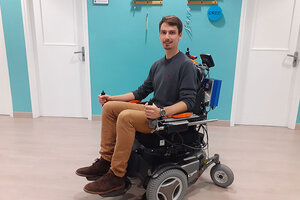Care robotics can help patients with Duchenne muscular dystrophy (DMD)
An IRSJD research team develop a robotic wheelchair helps to improve the physical condition of people with Duchenne muscular dystrophy.
Electric wheelchairs are an essential technology to support mobility and maintain independence and social participation. However, continued use leads to high levels of sedentary behaviour, which in turn lead to secondary functional deterioration of the muscular, skeletal, cardiovascular and respiratory systems and to accelerating the loss of arm function.
Appropriate and long-term physical training can help preserve the functional abilities of people with Duchenne muscular dystrophy. The wheelchair developed in the framework of the MOVit project integrates robotic arms instead of armrests. The system allows users to control the direction and speed of the wheelchair just by performing a cyclical arm motion.
Instead of using a joystick, with MOVit patients have the opportunity to drive the chair by exercising muscle arms, which suffer from loss of tone due to the disease. In addition, the system can be adapted to the activity and physical training needs of each patient.
The system has been incorporated to an existing wheelchair model and it is the result of teamwork between Julita Medina and Josep Maria Font, Institut de Recerca Sant Joan de Déu, and Joan Lobo, a former researcher at the consolidated research group Robot Perception and Manipulation of the Institute of Robotics and Industrial Informatics (IRI), which is a joint research centre of the Higher Spanish National Research Council (CSIC) and the Universitat Politècnica de Catalunya · BarcelonaTech (UPC). The project has had the support of the University of California, Irvine (UCI)and the organisation Duchenne Parent Project Netherlands, which has funded the MOVit robotic wheelchair.
Dynamic and tailored physical training
International care guidelines for DMD recommend performing certain exercises on a regular basis and avoiding high-intensity exercises. Although there is no consensus on a specific exercise routine, a study has shown that an appropriate and long-term physical training routine (assisted bicycle training of the legs and arms for 6 months) can help to preserve functional abilities of people with DMD.
Currently, users in wheelchairs whether electric or not need to go or be taken to the exercise machines or equipment and then exercise for a fixed period of time. In contrast, people without a disability have many opportunities to integrate exercise into daily life: cycling or walking to work, climbing stairs, etc. Integrated daily exercise is one of the most effective ways to promote health and wellbeing.
Young DMD patients aged between 12 and 18 participated in the pilot study of the MOVit project, which was conducted between July and November 2019 in the Biomechanical Engineering Lab at the UPC's CREB. The study aimed to check if they could control the wheelchair correctly by moving their arms and to compare driving performance using a conventional joystick. In addition, the study determined how resistance, arm movement amplitude and frequency affect heart rate and arm muscle activation.
Driving through arm motion
The MOVit system is a wheelchair with two robotic arm supports that is driven just by performing a cyclical arm motion. The right arm motion controls the speed of the right wheel and the left arm motion controls the speed of the left wheel. You can switch the direction of wheel rotation just by pressing a button on the top of the handle.
Other driving tests performed with a MOVit system prototype in a group of 24 healthy people showed that, after 30 minutes of training, driving accuracy and speed were comparable to those using a joystick. Heart rate and oxygen consumption data indicated that the MOVit system provides low-intensity exercise training similar to walking.
Source of information
A robotic wheelchair helps to improve the physical condition of people with Duchenne muscular dystrophy. Universitat Politècnica de Catalunya · BarcelonaTech (UPC).

This inherited neuromuscular disorder affects one in 3,500 children worldwide and patients have an average life expectancy of 35 years.
